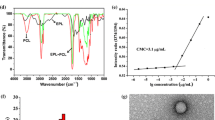Abstract
Anti-bacterial materials play significant role in biomedical field. Researches and applications of new anti-bacterial materials are necessary. Novel linear and star-shaped copolymers of poly(caprolactone)-poly(quaternary ammonium salt) (PCL-PJDMA) were synthesized by a combination of ring-opening polymerization and atom transfer radical polymerization. The structures of the copolymers were confirmed by nuclear magnetic resonance (1H-NMR) and Fourier transform infrared spectroscopy. The copolymers self-assembled into ball-shaped micelles with low critical micelle concentration (10−4∼10−3 mg/ml). An anti-bacterial drug, triclosan, was chosen as a model drug to investigate the potential application of the copolymers in drug-controlled release. The anti-bacterial experiments against Escherichia coli indicated that all the copolymer micelles had anti-bacterial ability and drug-loaded star-shaped PCL-PJDMA micelles were the best. The slow release of the drug from the drug-loaded micelles prolonged anti-bacterial effect. Therefore, PCL-PJDMA themselves have not only anti-bacterial ability but also the copolymer micelles can be used as carriers for anti-bacterial drugs.










Similar content being viewed by others
References
Boyer C, Teo J, Phillips P, Erlich RB, Sagnella S, Sharbeen G, Dwarte T, Duong HT, Goldstein D, Davis TP, Kavallaris M, McCarroll J (2013) Effective delivery of siRNA into cancer cells and tumors using well-defined biodegradable cationic star polymers. Mol Pharm 10(6):2435–44. doi:10.1021/mp400049e
Carmona-Ribeiro A, de Melo Carrasco L (2013) Cationic antimicrobial polymers and their assemblies. Int J Mol Sci 5(14):9906–46. doi:10.3390/ijms14059906
Cho HY, Srinivasan A, Hong J, Hsu E, Liu S, Shrivats A, Kwak D, Bohaty AK, Paik H, Hollinger OJ, Matyjaszewski K (2011) Synthesis of biocompatible peg-based star polymers with cationic and degradable core for siRNA delivery. Biomacromolecules 12(10):3478–86. doi:10.1021/bm2006455
Fang M, Chen J, Xu X, Yang P, Hildebrand HF (2006) Antibacterial activities of inorganic agents on six bacteria associated with oral infections by two susceptibility tests. Int J Antimicrob Agents 6(27):513–7
Jia Z, Shen D, Xu W (2001) Synthesis and antibacterial activities of quaternary ammonium salt of chitosan. Carbohydr Res 1(333):1–6. doi:10.1016/S0008-6215(01)00112-4
Kenawy E, Worley SD, Broughton R (2007) The chemistry and applications of antimicrobial polymers: a state-of-the-art review. Biomacromolecules 5(8):1359–84. doi:10.1021/bm061150q
Kuroda KDW (2005) Amphiphilic polymethacrylate derivatives as antimicrobial agents. J Am Chem Soc 127:4128–9. doi:10.1021/ja044205
Kuroda K, Caputo GA, DeGrado WF (2009) The role of hydrophobicity in the antimicrobial and hemolytic activities of polymethacrylate derivatives. Chem Eur J 5(15):1123–33. doi:10.1002/chem.200801523
Mi L, Bernards MT, Cheng G, Yu Q, Jiang S (2010) pH responsive properties of non-fouling mixed-charge polymer brushes based on quaternary amine and carboxylic acid monomers. Biomaterials 10(31):2919–25. doi:10.1016/j.biomaterials.2009.12.038
Moreira MDR, Pereda M, Marcovich NE, Roura SI (2011) Antimicrobial effectiveness of bioactive packaging materials from edible chitosan and casein polymers: assessment on carrot, cheese, and salami. J Food Sci 1(76):M54–63. doi:10.1111/j.1750-3841.2010.01910.x
Muñoz-Bonilla A, Fernández-García M (2012) Polymeric materials with antimicrobial activity. Prog Polym Sci 2(37):281–339. doi:10.1016/j.progpolymsci.2011.08.005
Nam CW, Kim YH, Ko SW (1999) Modification of polyacrylonitrile (PAN) fiber by blending with N‐(2‐hydroxy) propyl‐3‐trimethyl‐ammonium chitosan chloride. J Appl Polym Sci 9(74):2258–65. doi:10.1002/(SICI)1097-4628(19991128)
Palermo EF, Kuroda K (2009) Chemical structure of cationic groups in amphiphilic polymethacrylates modulates the antimicrobial and hemolytic activities. Biomacromolecules 6(10):1416–28. doi:10.1021/bm900044x
Palermo EF, Kuroda K (2010) Structural determinants of antimicrobial activity in polymers which mimic host defense peptides. Appl Microbiol Biotechnol 5(87):1605–15. doi:10.1007/s00253-010-2687-z
Politzer P, Murray JS, Clark T (2013) Halogen bonding and other σ-hole interactions: a perspective. Phys Chem Chem Phys 27(15):11178–89. doi:10.1039/C3CP00054K
Timofeeva L, Kleshcheva N (2011) Antimicrobial polymers: mechanism of action, factors of activity, and applications. Appl Microbiol Biotechnol 3(89):475–92. doi:10.1007/s00253-010-2920-9
Zhang X, Liu M, Yang B, Zhang X, Wei Y (2013) Tetraphenylethene-based aggregation-induced emission fluorescent organic nanoparticles: facile preparation and cell imaging application. Colloids Surf B: Biointerfaces 1(12):81–6. doi:10.1016/j.colsurfb.2013.07.052
Zhu CH, Jung S, Luo SB, Meng FH, Zhu XL, Park TG, Zhong ZY (2010) Co-delivery of siRNA and paclitaxel into cancer cells by biodegradable cationic micelles based on PDMAEMA-PCL-PDMAEMA triblock copolymers. Biomaterials 8(31):2408–16. doi:10.1016/j.biomaterials.2009.11.077
Acknowledgments
This work was supported by the National Natural Science Foundation of China (no. 51473099 and 51273125). We would also like to appreciate our laboratory members for the generous help and gratefully acknowledge the Analytical and Testing Center at Sichuan University for test.
Author information
Authors and Affiliations
Corresponding author
Ethics declarations
Conflict of interest
The authors declare that they have no competing interests.
Ethical statement
This article does not contain any studies with human participants or animals performed by any of the authors.
Rights and permissions
About this article
Cite this article
Leng, M., Hu, S., Lu, A. et al. The anti-bacterial poly(caprolactone)-poly(quaternary ammonium salt) as drug delivery carriers. Appl Microbiol Biotechnol 100, 3049–3059 (2016). https://doi.org/10.1007/s00253-015-7126-8
Received:
Revised:
Accepted:
Published:
Issue Date:
DOI: https://doi.org/10.1007/s00253-015-7126-8




